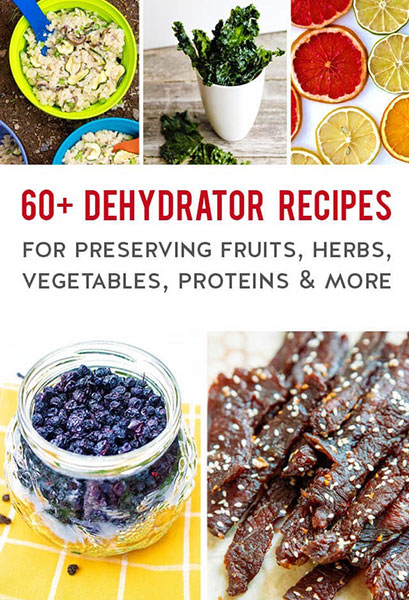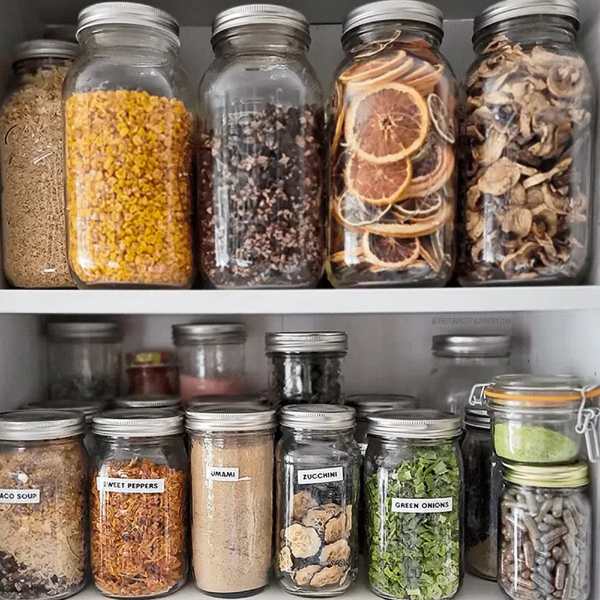
Content Menu
● Understanding Food Dehydration
● Benefits of Using a Food Dehydrator
● Foods That Can Be Dehydrated
>> 1. Fruits
>> 2. Vegetables
>> 3. Meats
>> 4. Herbs
>> 5. Grains and Legumes
>> 6. Complete Meals
● Snacks and Treats
● Unique Items
● Tips for Successful Dehydration
● How to Use a Food Dehydrator
● Common Mistakes to Avoid
● Detailed Recipes for Popular Foods
>> Fruits
>>> Apples:
>>> Bananas:
>>> Strawberries:
>> Vegetables
>>> Carrots:
>>> Tomatoes:
>> Meats
>>> Beef Jerky:
● Creative Uses for Dried Foods
● Storage Solutions
● Conclusion
● FAQs
>> 1. What foods should not be dehydrated?
>> 2. How long does it take to dehydrate food?
>> 3. Can I dehydrate cooked food?
>> 4. How should I store dehydrated foods?
>> 5. Can I rehydrate dried foods?
● Citations:
Food dehydrators are versatile appliances that allow you to preserve a wide variety of foods by removing moisture. This process not only extends the shelf life of food but also concentrates flavors and nutrients. In this article, we will explore the different types of foods that can be dehydrated, the benefits of using a food dehydrator, and tips for successful dehydration.

Understanding Food Dehydration
Dehydration is one of the oldest methods of food preservation. By removing moisture, you inhibit the growth of bacteria, yeast, and mold, thereby extending the shelf life of foods. A food dehydrator works by circulating warm air around the food at low temperatures, typically between 85°F to 160°F. This gentle drying process helps retain the nutrients and flavors of the food better than other cooking methods.
Benefits of Using a Food Dehydrator
Using a food dehydrator offers numerous benefits:
- Extended Shelf Life: Dehydrated foods can last for months or even years when stored properly.
- Nutrient Preservation: Dehydrating at low temperatures helps retain vitamins and minerals.
- Reduced Waste: Dehydrating surplus fruits and vegetables prevents spoilage and waste.
- Cost-Effective: Buying seasonal produce in bulk and dehydrating it can save money in the long run.
Foods That Can Be Dehydrated
A wide range of foods can be successfully dehydrated. Here's an overview:
1. Fruits
Fruits are among the most popular items to dehydrate due to their natural sugars and flavors. Common fruits that can be dehydrated include:
- Apples
- Bananas
- Strawberries
- Mangoes
- Pineapples
- Peaches
- Grapes (to make raisins)
When dehydrating fruits, it's often beneficial to slice them thinly to ensure even drying. Some fruits may require pretreatment with lemon juice to prevent browning.
2. Vegetables
Vegetables can also be easily dehydrated, making them perfect for soups, stews, and snacks. Some great options include:
- Carrots
- Bell peppers
- Zucchini
- Tomatoes
- Onions
- Mushrooms
- Spinach
Blanching certain vegetables before dehydration can help preserve color and texture.

3. Meats
Dehydrating meats is a bit more complex but can yield delicious results like jerky. Suitable meats include:
- Lean beef (trimmed of fat)
- Chicken (cooked first)
- Turkey
- Fish (like salmon or tuna)
It's crucial to cook meats to a safe temperature before dehydrating to kill harmful bacteria.
4. Herbs
Fresh herbs can be dried easily in a food dehydrator, enhancing their flavor for later use in cooking. Popular herbs include:
- Basil
- Oregano
- Thyme
- Rosemary
- Mint
5. Grains and Legumes
While not as common, grains like rice and legumes such as beans can also be dehydrated. This is particularly useful for camping or emergency preparedness.
6. Complete Meals
You can even dehydrate complete meals like stews or casseroles by spreading them onto non-stick sheets in your dehydrator. This method is especially handy for backpacking meals.
Snacks and Treats
Dehydrators are fantastic for creating healthy snacks such as fruit leathers or veggie chips. You can blend fruits with a bit of sweetener to create fruit rolls or make crispy kale chips seasoned with your favorite spices.
Unique Items
Some unique items that can be dehydrated include:
- Yogurt: You can dehydrate yogurt to create yogurt powder for smoothies or baking.
- Eggs: Dehydrating scrambled eggs provides a lightweight protein source for camping.
- Sauces: Certain sauces can be dried into powders for easy storage and rehydration later.
Tips for Successful Dehydration
To ensure successful dehydration, consider the following tips:
1. Slice Uniformly: Cut food into uniform sizes to promote even drying.
2. Avoid Overloading: Do not overcrowd trays; ensure air circulation around each piece.
3. Monitor Temperature: Use appropriate temperatures for different foods (e.g., fruits at 135°F, vegetables at 125°F).
4. Store Properly: After dehydration, store foods in airtight containers in a cool, dark place to prolong shelf life.
How to Use a Food Dehydrator
Using a food dehydrator is straightforward:
1. Preparation: Start with fresh produce and meat; wash them thoroughly before use.
2. Cutting: Slice your food into even pieces for uniform drying.
3. Pretreatment: Some fruits may require pretreatment with lemon juice or blanching vegetables.
4. Loading the Dehydrator: Place your food on the trays without overcrowding them.
5. Setting Temperature: Adjust the temperature according to the type of food being dried.
6. Timing: Monitor the drying process periodically; it may take several hours depending on the food type.
Common Mistakes to Avoid
To maximize your success with dehydration, avoid these common mistakes:
- Not checking moisture levels regularly during dehydration.
- Overcrowding trays which leads to uneven drying.
- Using high temperatures that may cook rather than dehydrate your food.
Detailed Recipes for Popular Foods
Fruits
Fruits are not only delicious but also incredibly versatile when it comes to dehydration.
Apples:
To make apple chips:
1. Slice apples thinly (about 1/8 inch).
2. Dip slices in lemon juice mixed with water (to prevent browning).
3. Arrange slices on trays without overlapping.
4. Set the dehydrator at 135°F for about 6–8 hours until crisp.
Bananas:
For banana chips:
1. Peel bananas and slice them into coins (1/4 inch thick).
2. Optionally dip in lemon juice or sprinkle with cinnamon.
3. Place on trays and dehydrate at 135°F for about 6–10 hours until chewy yet firm.
Strawberries:
To dry strawberries:
1. Remove stems and slice strawberries in half or quarters.
2. Arrange on trays without overlapping.
3. Dehydrate at 135°F for about 6–8 hours until leathery but not sticky.
Vegetables
Vegetables retain their flavor well when dried properly.
Carrots:
For carrot chips:
1. Peel carrots and slice them thinly (1/8 inch).
2. Blanch slices in boiling water for 2 minutes then cool immediately in ice water.
3. Drain well before placing on trays.
4. Dehydrate at 125°F for about 8–10 hours until crisp.
Tomatoes:
For sun-dried tomatoes:
1. Slice tomatoes in half lengthwise.
2. Sprinkle lightly with salt if desired.
3. Place cut-side up on trays.
4. Set at 135°F for about 10–12 hours until they resemble dried fruit but still have some pliability.
Meats
Dehydrating meats requires careful preparation but yields fantastic results like jerky.
Beef Jerky:
To make beef jerky:
1. Use lean cuts like flank steak; trim all fat off.
2. Slice meat against the grain into thin strips (about 1/4 inch).
3. Marinate strips in your favorite marinade overnight in the refrigerator.
4. Drain excess marinade before placing strips on trays.
5. Dehydrate at 160°F for about 6–8 hours until dry yet slightly pliable.
Creative Uses for Dried Foods
Dried foods offer unique culinary opportunities beyond snacking:
- Add dried fruits like apricots or peaches into oatmeal or yogurt for breakfast.
- Incorporate rehydrated vegetables into casseroles or stir-fries as quick meal solutions.
- Use powdered dried vegetables as seasoning mixes or thickeners in soups and sauces.
Storage Solutions
Proper storage is crucial for maintaining quality:
1. Use glass jars with tight-fitting lids or vacuum-sealed bags to keep out moisture.
2. Store jars in dark places away from light exposure which can degrade quality over time.
3. Label jars with dates so you know when they were dehydrated; aim to consume within one year for best quality.
Conclusion
Food dehydrators are an excellent investment for anyone looking to preserve their favorite foods while enhancing flavors and reducing waste. With a wide array of fruits, vegetables, meats, herbs, snacks, and even complete meals that can be dried, the possibilities are endless. By following proper techniques and storage methods, you can enjoy delicious dehydrated snacks and ingredients year-round.

FAQs
1. What foods should not be dehydrated?
High-fat foods such as avocados and nut butters do not dehydrate well because they can become rancid over time.
2. How long does it take to dehydrate food?
Dehydration times vary depending on the type of food and thickness but typically range from 4 to 12 hours.
3. Can I dehydrate cooked food?
Yes! You can dehydrate cooked meals; just ensure they are spread evenly on trays for proper drying.
4. How should I store dehydrated foods?
Store dehydrated foods in airtight containers or vacuum-sealed bags in a cool, dark place to maximize shelf life.
5. Can I rehydrate dried foods?
Yes! Most dried foods can be rehydrated by soaking them in water or adding them directly to soups or stews during cooking.
Citations:
[1] https://www.webstaurantstore.com/guide/741/food-dehydrators-buying-guide.html
[2] https://vacuumsealersunlimited.com/how-to-use-a-food-dehydrator/
[3] https://www.youtube.com/watch?v=7wB8g22taqo
[4] https://www.commercialdehydrators.com.au/dehydrating-recipes-filters
[5] https://www.bestbuy.com/discover-learn/10-reasons-to-buy-a-food-dehydrator/pcmcat1634332391134
[6] https://www.youtube.com/watch?v=lEUA2t2XD5M
[7] https://www.thepurposefulpantry.com/essential-dehydrated-foods-for-the-pantry/
[8] https://www.youtube.com/watch?v=rXNIHzcE8F0
[9] https://www.webmd.com/diet/dehydrating-food-good-for-you
[10] https://homesteadlady.com/best-foods-to-dehydrate/
[11] https://www.goodhousekeeping.com/appliances/a31904157/what-is-a-dehydrator/
[12] https://www.freshoffthegrid.com/dehydrating-food/
[13] https://www.backpackingchef.com/dehydrating-food.html
[14] https://slowerhiking.com/food/adapt-your-favourite-recipes
[15] https://cosori.com/blogs/blog/how-does-a-food-dehydrator-work
[16] https://homesteadingfamily.com/preservation-101-intro-to-dehydrating-food/
[17] https://www.foodie.com/1398031/foods-should-dehydrate-list/
[18] https://www.backpackingchef.com/food-dehydrator-recipes.html
[19] https://brodandtaylor.com/pages/dehydrating
[20] https://learn.eartheasy.com/guides/a-beginners-guide-to-dehydrating-food/
[21] https://fooddrinklife.com/best-foods-to-deydrate/
[22] https://insanelygoodrecipes.com/dehydrator-recipes/
[23] https://www.healthline.com/nutrition/dehydrated-food
[24] https://www.breville.com/content/breville/us/en/blog/cooking/how-to-use-a-dehydrator/_jcr_content/root/container_741553154/container/image.coreimg.85.1200.jpeg/1718622778417/how-to-use-dehydrator.jpeg?sa=X&ved=2ahUKEwjIkaOQ1ueKAxXsElkFHa4PM0sQ_B16BAgIEAI
[25] https://www.eatingwell.com/article/290910/how-to-dehydrate-fruits-and-vegetables-for-a-healthy-snack/
[26] https://www.youtube.com/playlist?list=PL6ygl2lNPriODiu2XahnHHUhj6mEObz0P
[27] https://community.waring.com/blog/p/13or1/the-remarkable-benefits-of-adding-a-food-dehydrator-to-your-kitchen-arsenal
[28] https://www.allrecipes.com/article/how-to-use-a-food-dehydrator/
[29] https://www.osbheatpump.com/news/how-to-use-a-food-dehydrator-10-useful-tips-for-beginners-and-advanced-users/
[30] https://eatsleepwild.com/homemade-dehydrated-backpacking-meals/











